
Avisaurus is a genus of enantiornithine bird from the Late Cretaceous of North America.

Bradycneme is a genus of theropod dinosaur from the Maastrichtian-age Upper Cretaceous Sânpetru Formation of the Hațeg Basin, Transylvania, Romania. The genus contains a single species, Bradycneme draculae, known only from a partial right lower leg, which its original describers believed came from a giant owl.

Elopteryx is a genus of, perhaps troodontid, maniraptoran theropod dinosaur based on fragmentary fossils found in late Cretaceous Period rocks of Romania. The single species, Elopteryx nopcsai, is known only from very incomplete material, and therefore is considered a nomen dubium by most paleontologists.
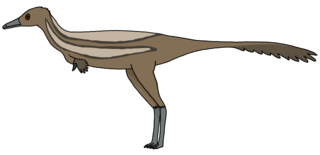
Heptasteornis is the name given to a potentially dubious genus of alvarezsaurid dinosaur from the Late Cretaceous. The type species is Heptasteornis andrewsi, described as a presumed gigantic prehistoric owl in 1975. It was previously included in Elopteryx nopcsai and indeed the holotypes of both were believed to be from the same individual as they were discovered, and initially were assigned the same specimen number. This appears to be in error however.

Noasaurus is a genus of ceratosaurian theropod dinosaur genus from the late Campanian-Maastrichtian of Argentina. The type and only species is N. leali.
Enantiornis is a genus of Enantiornithes. The type and only currently accepted species E. leali is from the Late Cretaceous Lecho Formation at El Brete, Argentina. It was described from specimen PVL-4035, a coracoid, proximal scapula and proximal humerus found close to each other and suspected to represent the left shoulder of a single individual.

Hatzegopteryx is a genus of azhdarchid pterosaur found in the late Maastrichtian deposits of the Densuş Ciula Formation, an outcropping in Transylvania, Romania. It is known only from the type species, Hatzegopteryx thambema, named by Buffetaut et al. in 2002 based on parts of the skull and humerus. Additional specimens, including a neck vertebra, were later placed in the genus, representing a range of sizes. The largest of these remains indicate it was among the biggest pterosaurs, with an estimated wingspan of 10 to 12 metres.
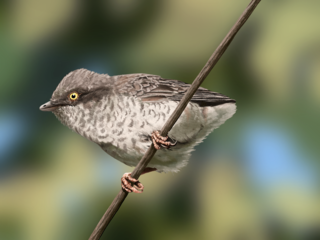
Alexornis is a genus of enantiornithine birds from the Bocana Roja Formation of Baja California, Mexico. This geological formation has been dated to the late Cretaceous period, and more specifically to the Campanian age, about 73 mya. The type and only known species is Alexornis antecedens. Its name means "Alex's ancestral bird"; Alexornis from the given name of ornithologist Alexander Wetmore + Ancient Greek ornis, "bird", and antecedens, Latin for "going before" or "ancestral".

Yungavolucris is a genus of enantiornithean birds. It contains the single species Yungavolucris brevipedalis, which lived in the Late Cretaceous. The fossil bones were found in the Lecho Formation at estancia El Brete, Argentina."Yungavolucris brevipedalis" means "Short-footed Yungas bird". The generic name, Yungavolucris is after the Yungas region + the Latin volucris, which translates to "bird". The specific name brevipedalis is from the Latin brevis, which means "short", + pedalis, from the Latin pes, meaning "foot".

Lectavis is a genus of enantiornithine birds. Their fossil bones have been recovered from the Late Cretaceous Lecho Formation at estancia El Brete, Argentina. The genus contains a single species, Lectavis bretincola.
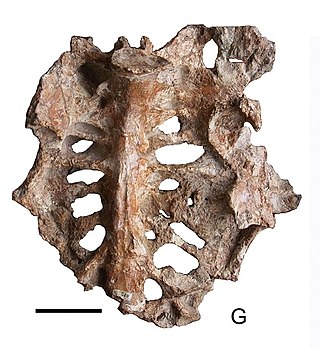
Gargantuavis is an extinct genus of large, primitive bird containing the single species Gargantuavis philoinos. It is the only member of the monotypic family Gargantuaviidae. Its fossils were discovered in several formations dating to 73.5 and 71.5 million years ago in what is now northern Spain, southern France, and Romania. Gargantuavis is the largest known bird of the Mesozoic, a size ranging between the cassowary and the ostrich, and a mass of 141 kg (311 lb) like modern ostriches, exemplifying the extinction of non-avian dinosaurs was not a necessary condition for the emergence of giant terrestrial birds. It was once thought to be closely related to modern birds, but the 2019 discovery of a pelvis from what was Hateg Island shows several primitive features.
Gurilynia is a genus of enantiornithine birds. One species is known, G. nessovi. It lived during the Maastrichtian stage of the Late Cretaceous period, between 70 and 66 mya. Gurilynia is known from fragmentary fossils found at the Gurilyn Tsav locality of the Nemegt Formation in south Gobi, Mongolia.
Neuquenornis volans is a species of enantiornithean birds which lived during the late Cretaceous period in today's Patagonia, Argentina. It is the only known species of the genus Neuquenornis. Its fossils were found in the Santonian Bajo de la Carpa Formation, dating from about 85-83 million years ago. This was a sizeable bird for its time, with a tarsometatarsus 46.8mm long. Informal estimates suggest that it measured nearly 30 cm (12 in) in length excluding the tail.

Avisauridae is a family of extinct enantiornithine dinosaurs from the Cretaceous period, distinguished by several features of their ankle bones. Depending on the definition used, Avisauridae is either a broad and widespread group of advanced enantiornithines, or a small family within that group, restricted to species from the Late Cretaceous of North and South America.
Soroavisaurus is a genus of enantiornithean birds related to Avisaurus. It lived during the Late Cretaceous of Argentina. The only known species, S. australis, is known from fossils collected from the Lecho Formation of Estancia El Brete, in the southern tip of the province of Salta, Argentina. A binominal name of this animal means "Southern sister Avisaur".

Bauxitornis is an extinct genus of avisaurid enantiornithean birds which lived in what is now Hungary during the late Cretaceous period. Although first mentioned in a 2008 review of Hungarian Cretaceous bird fossils, it was named in a more comprehensive review by Gareth J. Dyke and Attila Ősi in 2010. The type species is Bauxitornis mindszentyae. The generic name "Bauxitornis" refers to the locality at which it was discovered, a Bauxite mine. The specific name "mindszentyae" honors Andrea Mindszenty, Ősi's advisor.
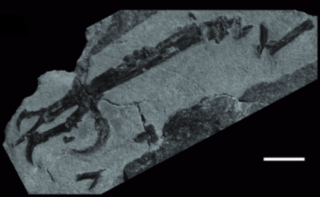
Intiornis is an extinct genus of avisaurid enantiornithean birds which existed in what is now North-West Argentina during the late Cretaceous period.
Elbretornis is an extinct genus of enantiornithine which existed in what is now Salta Province, Argentina during the late Cretaceous period.
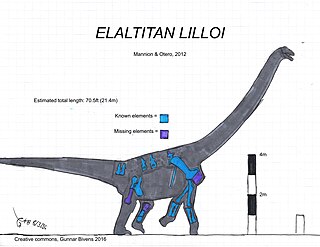
Elaltitan is an extinct genus of large lithostrotian titanosaur sauropod dinosaur known from the Late Cretaceous of Chubut Province, southern Argentina. It contains a single species, Elaltitan lilloi.

Yatenavis is an extinct genus of enantiornithine bird from the Late Cretaceous Chorrillo Formation of Santa Cruz Province, Argentina. The genus contains a single species, Y. ieujensis, known from a partial humerus.
















